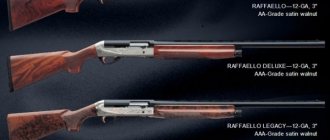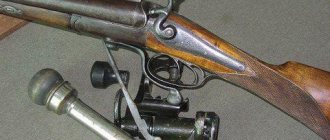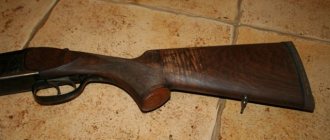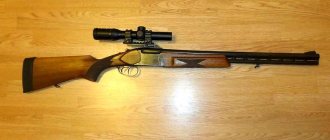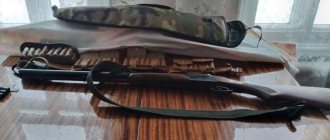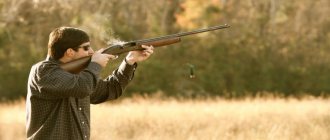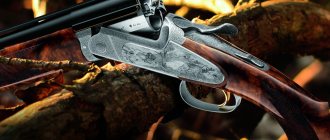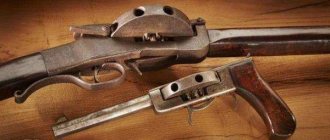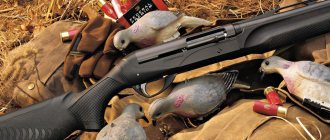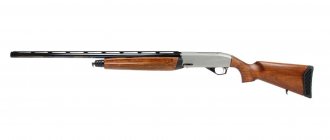Among shotguns of all companies, brands and systems, the famous shotguns of James Perde (pronounced Pede in English) occupy a special place. Experts consider them outstanding, and many even give them first place. The guns of this company were well known in Russia, where they were highly valued. L.P. Sabaneev wrote: “The head of the London gunsmiths is... James Perde.”
S. A. Buturlin was the first to name guns from the Perde company among the first-class hand-made guns that served as “models for gunsmiths all over the world.” The founder of the company, James Perde (1784-1863), himself the son of a gunsmith, was a highly skilled gunsmith and, of course, a man who knew how to run a business. At the end of the Napoleonic Wars, he organized the production of hunting rifles in London.
James Perde's percussion-capsule shotgun systems
That was the time when percussion-capsule systems began to replace flint-percussion systems. Light weight, thin but very durable barrels made from the best barrel materials, excellent performance of locks that do not misfire, excellent action and adaptability in combination with the latest powder charge ignition systems at that time - all this created a high reputation for the guns. James Perde is succeeded by his son, also James, traditionally called “Junior” (1824-1909), who in 1843. entered the business, and 20 years later, in 1863, after the death of his father, he took control of the company into his own hands.
1. James Perde percussion cap fitting. 30s - 40s of the 19th century.
2. James Perde's percussion-capsule smoothbore shotgun. 30-40s. years. XIX century
James Perde and Sons
Weapon production expanded (250 guns were produced per year), and in 1879. His two sons get involved. The name remains as such to this day. The era when ramrod weapons were replaced by breech-loading weapons opened up broad prospects for gunsmiths. Various systems are created and tested, some of which are forever forgotten or serve as curious exhibits in museums, others are developed and improved. J. Perde Jr. also makes an undoubted contribution to the development of weapons manufacturing.
Several inventions and improvements are associated with his name, among which the most outstanding is the “Perdet frame,” invented in the 70s of the last century. The frame is located in the gun block and serves to connect the barrels to the block. This frame fits into the grooves in the hooks of the barrels when closing the gun and releases the hooks when you press the key that controls it.
This part of the locking mechanism provides such a strong fastening that in some cases there is no need for top locking. The Perdet frame is still installed on almost all types of shotguns with horizontally paired barrels; it is often installed on shotguns with vertically paired barrels. In 1856, the company produced several double-barreled rifles called “express”, and from that time the term “express” began to be used to designate hunting rifled weapons with a high muzzle velocity and flat firing. Since the mid-70s, it has become clear to advanced gunsmiths that the future belongs to hammerless systems.
3. Classic model of a smoothbore double-barreled shotgun by James Perde. 1891/1892
Guns “Purdey Sons” (James Purdey & Sons, Ltd).
Among the world-famous English gunsmiths, James Purdey & Sons, Ltd. takes its place of honor. It is part of the London school of the legendary Joseph Menton, with whom Perde the Father, the founder of the company, worked for some time. Now the name of the company is not just a brand, but a real world legend. Perde guns are always a good investment as they only increase in value over time.
History of creation
The legendary arms company was created by James Perde in 1814, but the doors of the armory were opened two years later - in 1816. Before opening his own business, he already had experience as a gunsmith. In 1803, James was apprenticed to Menton, a master gunsmith who was rapidly gaining fame at the time. This work forever left a mark on James' life. In the future, Menton's style was clearly visible in the gunsmith's works. In 1806, Perde worked as a manager for the famous Scottish gunsmith Forsyth. Here he became interested in the work of the master in constructing a capsule lock, as well as his chemical experiments. It was in this workshop that Perde became an inquisitive inventor.
The workshop Perde opened was located on Princes Street, but in 1826 James moved his production to the workshops of teacher Joseph Menton on Oxford Street. At that time, Menton had already retired, and the arrival of Perde became a symbolic event in the passing of the baton from the master to his student.
In 1838, the Perdet armory experienced its first great success - it became known that Queen Victoria herself had purchased a couple of pistols from this workshop. In the future, this company will have many more deliveries of weapons to the royal court.
The youngest of his five sons, also named James, continued his father’s work. He took over the production after his father's death in 1863. Under his management, a simple handicraft workshop turned into a small factory. This was facilitated by the construction in 1881 of new spacious factory premises - Oldley House.
The rise of the company
The company's prosperity was facilitated by the historical era in which it was founded. This was the heyday of the English Empire, when almost every day new territories were being explored and expeditions were made to uncharted lands. It seemed that there would be no end to the state’s possessions - various continents, islands, climatic zones and natural conditions. Pioneers, travelers and adventurers were in great need of weapons, including hunting ones. James Perde Jr., that is, the son of the company's founder, in addition to being a skilled gunsmith, was also a skilled entrepreneur. He constantly studied the needs of a huge market. To do this, the master visited athletes in pigeon cages, and his workshop was often visited by professional hunters and adventure lovers. He knew that the main success of commerce is constant progress and the supply of new products to the market.
It was Perde Jr. who was the first to create and begin to sell special large-caliber rifles that were intended for hunting large African game. Because of their power, he called them “expresses.” This term has survived to this day, and now “express” refers to all double-barreled large-caliber rifled weapons of this type.
Technological innovations
Perde Jr. was a truly talented inventor. Some of his creations were borrowed by weapons production in many countries around the world. For example, in 1867 the master created his own barrel locking system. It's called the Perde frame. The frame serves to connect the barrels to the block. When closing the gun, the frame fits into the grooves of the barrel hooks, firmly locking the barrels. Even today, almost no horizontal double-barreled shotgun can do without a Perde frame.
Beginning in 1881, the Perde Jr. company began producing hammerless guns. They simply became the standard of quality for other gunsmiths. All Perde tried to produce guns with padlocks, since such weapons had a more pleasant appearance. And in 1880, Perde patented his own lock, the creator of which was F. Beasley, who worked for the master. This lock remains the pinnacle of perfection to this day, and not a single company has been able to improve it for many years. In this lock, cocking is carried out when opening the gun; closing the gun compresses the mainspring. The mainspring bends have different stiffnesses. When opening the gun, the upper bend of the spring rotates the hammer until it is fully cocked. The mainspring remains unpressurized until the gun is closed. The upper bend of this same mainspring, when pulling the locking frame out of the recesses in the under-barrel hooks, forces the barrels to open. Thus, as soon as the key is moved to the side, the gun opens independently, without requiring any effort from the shooter. In this case, spent cartridges are automatically ejected using an ejector.
Perde-Beasley locks are installed on the side boards. They can be easily removed and cleaned or repaired anywhere, even in the jungle. This is an extremely reliable and durable design, which requires the highest quality metalwork during its manufacture.
The self-opening gun, the creation of the ingenious thought of Beasley-Purde, is considered the highest achievement of the famous London company. It was this that brought the gunsmiths simply colossal commercial success.
Life after Perde Jr.
After the death of James Perde Jr. in 1909, his son, Ethol Stewart, took over the helm of the company. Ten years later, the company was headed by Thomas Perde, the son of Etol. From 1954 the company was represented by Lord Sherwood, and from 1971 by Richard Beaumont. In 1994, the company was sold, and Richemont Group became its owner. In 2007, Nigel Beaumont became chairman of the company.
Perde and Sons today
Today the company offers custom hunting weapons. Weapons are still produced mainly using manual labor, one might say in a handicraft way. And all because of the main requirement - the highest quality of products. By the way, at one time Perde Jr. produced 100-150 guns a year. Today, his followers produce only 70 guns a year on special orders.
Today, Perde and Sons offer customers a classic model of Perde weapons - a model of a horizontal double-barreled shotgun, as well as a side-flint model. Caliber and choke are all at the discretion of the customer. In addition, the company produces a variety of hunting accessories, and also carries out tremendous work on restoring its own old weapons.
In order to become the owner of an exclusive gun, the customer will need to fill out an extremely detailed questionnaire, the volume of which is at least 70 points, make an advance payment in the amount of a third of the order cost and wait 1.5–2 years. All this will cost him 100 thousand euros, and if the order is urgent, then almost twice as much.
Thus, a Best brand shotgun made in the 1920s with 32” barrels will cost somewhere around 20–25 thousand euros, a rifle of the same caliber made in 1884 is valued at 35 thousand euros, for a Deluxe Extra Finish 12-gauge horizontal double-barreled shotgun made in 1954 with barrels 26” in excellent condition will cost about 45 thousand euros. In general, guns from the 1920s without famous owners cost between 30 and 40 thousand euros.
The price of weapons from the 19th century in most cases exceeds 45–50 thousand euros, but in this case the condition of the old models plays a big role. If there was a historical figure among its owners, the price of such a weapon can increase several times.
Newer guns from the 20th century, despite their lower historical value, have a higher price, sometimes up to 70 thousand euros and more, since they are often sold in perfect condition.
Popularity among famous personalities
Thanks to the highest quality of products, it has become an elite weapons manufacturer. It is prestigious to have such a gun, so there have always been many famous personalities among the company’s clients.
Thus, even royalty were the company’s customers. In particular, King George V of England (reigned from 1910 to 1936) purchased guns from the company, of which he remained a fan all his life, never recognizing any other weapon.
Another fan of Perde's guns was the famous shooter Earl de Gray, who was also called Lord Ripon (1852-1923). He was such a fanatical hunter that he killed more than half a million birds in his life.
The Russian market was no less important for famous gunsmiths. It is known that the first famous customer from Russia was Prince Konstantin. He acquired a muzzle-loading capsule gun in 1847. Obviously, the court liked the weapon, since already in 1850 Tsar Nicholas I himself became a client of the company. His order consisted of four high-class muzzle-loading double-barreled shotguns.
The Russian royal orders did not stop there. The next customer was Tsar Nicholas II. In 1897, he ordered a set of twin hammerless weapons with ejectors. The guns were 12 gauge. Three years later, the tsar made another similar order, but this time the guns were already 16-caliber.
The firm’s clients included the Tsar’s uncle, Prince Konstantin Mikhailovich, and Prince Obolensky, who owns a pair of double-barreled shotguns.
Perdet products 1890–1910
In the period from 1890 to 1910, guns were actively supplied to Russia, not only at the expense of private customers, but also with the help of weapons companies. Well-known dealers of that time always included weapons from London craftsmen in their catalogs. What then did the company offer?
At the turn of the century, skeet shooting gained rapid popularity, replacing the extermination of live birds. The development of this sport contributed to the evolution of the self-opening action double-barreled shotgun in the form in which we now see it. The classic Perde-Beazley smoothbore double-barreled shotgun became a hit; it had no equal for 40 years. It gained competition only in 1922.
During this period, beskurovki gained popularity due to their obvious advantages. The company actively promoted their introduction to the market, but many of its customers remained fans of hammer-fired weapons. Therefore, Perde gunsmiths continued to produce them. By the way, since 2007, the company has resumed production of hammer-fired shotguns - horizontal guns of 12 and 20 calibers, equipped with classic lining locks. Their cost is no different from hammerless shotguns of a similar caliber.
Also at this time, the breech-loading double-barreled shotgun completely dominated. However, as in the case of hammer-fired guns, some of the company's clients did not change their preferences and ordered muzzle-loading weapons.
The company's guns are no less famous for their traditional engraving. It was introduced into the products by Perdeus engravers - Lucas and Mase, who worked at the company all their lives. They became the founders of English engraving using bouquets of roses and small arabesques. Subsequently, this style of decoration began to be called English engraving, and even now it is perhaps the main direction in decorating hunting weapons.
Another notable difference between Perde's weapons of this time is their gradual transition from Damascus to Whitworth steel. At first, barrels made of this steel were offered to customers only as an option. At the same time, it was indicated that Whitworth steel behaves better at high stresses. To obtain barrels made of new steel, it was necessary to pay a certain amount above the order price. Clients had to take their word for it, since it was impossible to see any visual differences between the materials.
In the catalogs of our trading companies you can find Perde weapons of categories A, B and C. What does this mean? Beginning in the 1870s, the company, like many arms manufacturers of those times, introduced a classification of its products into different categories. The best guns were those with padlocks on the side plates. They were called The Best and were classified as Category A. Double-barreled shotguns that used Anson & Deeley locks were classified as Category C, D and E. Almost all hammer-fired shotguns with neck locks were classified as Category E.
Weapons of the lower classes were collected by other gunsmiths, sometimes even from another city, and they were already engaged in their final processing. Over time, it became clear that such a system was not justified. Consumers have long been accustomed to the maximum quality of the company's products, and lower-class guns began to undermine the company's prestige. At the beginning of the twentieth century, fewer and fewer such weapons were produced, and until the 20s the company completely abandoned them, focusing exclusively on high-class guns.
Since then, the company has never changed its pursuit of ideals. Shotguns produced under their brand remain the standard of quality for hunting weapons to this day. But the corporate politics of idealism does not end there. The company pays special attention to all aspects of its activities. The personnel issue is no exception.
Hammerless systems
And although many hunters traditionally defended hammer-fired weapons, hammerless systems began to gain the right to life as they improved. Since 1881 began producing hammerless guns that have won worldwide recognition. Note that the lock for these guns was designed in 1880. talented gunsmith F. Beasley, who worked for Perde. Perde immediately appreciated this invention and soon received the right to use the Beasley castle.
The hundred years that have passed since the beginning of the manufacture of guns with locks of this system are the best proof of its remarkable qualities. In this system, unlike most others, the process of cocking the hammers and compressing the mainspring is divided into two stages. The hammers are cocked when the gun is opened, and the mainspring is compressed when it is closed. The basis of the lock (it is mounted on the side boards) is a V-shaped (double-arm) spring.
4. The same gun in an open form.
Its upper shoulder (shorter and stronger) serves to cock the hammer, and the lower (weaker) gives movement to the trigger when descending from the sear.
Each time the gun is closed, the mainsprings are charged, and each time the gun is opened, they are relaxed. This system requires very precise calculation of the lock and careful work. This is probably why it was repeated only in a small number of models (we have TS-2, MTs11).
5. James Perde's over-and-under shotgun.
PERDE guns
The name James was borne by four representatives of the legendary arms dynasty, but only two - Perde the Father (1784-1863) and Perde the Son (1828-1909) will forever remain the greatest gunsmiths. The first because he worked alongside Manton, Forsyth, Boss, Lancaster, the second because he created a double-barreled shotgun of modern design and construction. And yet, when the magic word “Perde” is uttered, the company is meant, not the specific owner. A company that has been producing and producing the most prestigious weapons in the world for two centuries.
The name of James Purde Jr. first attracted attention in 1856, when the Englishman released a muzzle-loading rifle and called it Express Train. Thus, thanks to the light hand of a London gunsmith, the concepts of “rifle-express”, “rifle-nitro-express”, etc. firmly entered the world terminology.
Everyone knows that the top control key (top lever) is an invention of Westley Richards. But to this day, only Westley Richards & Co puts a short triangular lever on its guns, no one else. The elegant, elongated Perde key, on the other hand, is all manufacturers of hunting weapons.
Well, it’s not hard to imagine what the Perde locking bar meant for gunsmiths. They received the strongest, almost universal connection between the barrels and the box, simple in design, technologically advanced in manufacturing, aesthetically pleasing, compatible with any control element, be it the upper, lower or side lever. In terms of popularity, the Perde frame has had no rivals for a century and a half!
The rise of J. Purdey & Sons Limited to the heights of world fame began 194 years ago, when 30-year-old father James Purdey rented premises at 4 Princes Street, London. And although the gunsmith opened the doors of the workshop only in 1816, all subsequent representatives of the dynasty referred to 1814, the year the company was founded.
After three years of practice with Manton (1805-1808), Father Perde was hired as a box maker for a priest, the venerable Doctor Alexander Forsyth, whose name enjoyed a high reputation among English clients. Close communication with Forsythe's influential clients further strengthened Purde's connections.
Despite his fame, the master signed his first products “James Purdey, From J. Manton’s” (“James Purdey, from D. Manton”), but soon abandoned this advertising trick, soberly reasoning that a good gunsmith’s own name was enough.
On August 1, 1826, James Purde moved to the workshop of D. Manton on Oxford Street (314 'D Oxford Street, London), which was the logical conclusion of the continuity of the extraordinary school created by the “king” of British gunsmiths. From that moment on, the name of Perde was inextricably linked with the name of Manton. The teacher himself, having retired, lived out his life modestly and died quietly on June 29, 1835.
From the first day of work at 4 Princes Street in 1816, Perde the Father introduced the simplest thing - continuous numbering of weapons. And since muzzle-loading shotguns, rifles, rifles and pistols came out of the London workshop, a strict system of consistent markings cannot but be considered the most convenient for historians and researchers of gun production. With the exception of the first products, which the master branded James Purdey, From J. Manton's, all subsequent weapons were usually signed like this: on the keyplates - Purdey or Purdey, London, on the barrels - James Purdey Oxford Street, London.
The founder Purde had five children, but only one of them, James Purde Jr., followed in his father's footsteps. The son was married twice and had a total of 13 children. His two eldest children, James (1854-1890) and Ethol Stewart (1858-1939), became their father's first partners, establishing a company on December 21, 1877, which since then, with a slight change in the official spelling (October 1925), has been called J Purdey & Sons Limited.
The second half of the 19th century in Great Britain was the heyday of political reforms, the scientific and technological revolution and colonial conquests. Purde Jr. was fortunate to work during a period when the British way of life flourished. The very first breech-loading gun was made in May 1858 - just five months after control passed into his hands. Until 1881, the company annually produced from 150 to 300 breech-loading guns of various systems and designs. These were double-barreled shotguns, mainly chambered for pinned cartridges, then hammer-fired ones appeared, and after them hammerless central rifles. At first, Perde tested various locking options with the lower levers that were popular in those years, until in 1863 he patented the connection of such a lever (underlever) with a lower two-way bar (or frame, as this element is commonly called in Russia), which fit into the grooves of the underbarrel hooks ( Fig. 1). 145 years have passed, but no one has come up with a more effective fastening, used in both expensive rifled guns and working smooth-bore guns!
The first guns did not have an upper locking unit. It appeared later in connection with the transition to smokeless gunpowder, which developed much higher pressures than black gunpowder. In 1878, Purde patented an addition to the lower locking bar in the form of an elegant rectangular protrusion on the breech end of the barrels, which was recessed into the window of the box panel (BP No. 397, 1878). A longitudinal or rotary bar hidden in the window, connected to the axis of the control key, was pushed onto the ledge (Fig. 2). The fastening did not interfere with the insertion of cartridges and looked very aesthetically pleasing, so it was loved by both hunters and gunsmiths. This third Perde locking unit has been associated with the most expensive guns for 130 years!
However, the highest achievement of the London company is a self-opening gun with a mechanism invented by Frederick Beesley (1846-1928). On December 18, 1879, the inventor sent D. Purde a letter, the essence of which was a request to familiarize himself with the principle of operation of the mechanism of the new hammerless gun (Fig. 3) and to acquire the rights to manufacture it.
Purde highly appreciated the invention and on August 5, 1880, he concluded an agreement with the author containing two options for the transfer of patent rights. On November 16, F. Beasley received a check for £35, and the London firm received a legally protected right to industrially produce guns with a self-opening mechanism for 14 years.
It was the gun designed by Beasley, the production of which began in 1881, that brought the British company stunning commercial success “that marked the beginning of the growth of the authority of Purde Jr. In the same year, construction began on a large factory building called Audley House in London on South Audley Street. In January 1883, the company occupied new spacious premises, and for 125 years the constant inscription has been on the barrels of its guns: J. Purdey & Sons, Audley House South Audley Street, London, England.
The double-barreled shotgun system in the classical form in which it is known now took shape by the beginning of the 20th century. The modern smooth-bore gun owes its perfect design and elegant shape to the popularization of driven shooting at pheasants, grouse and partridges, which, in fact, raised interest in it in British society. The desire of the hunting participants to get ahead of each other at all costs in terms of the number of downed birds has intensified competition among the best shotgun manufacturers. Orders to London gunsmiths came from all over the world. For more than forty years, the Beasley-Purde double-barreled shotgun had no competitors. It was not until 1922 that Holland & Holland Ltd. designed a self-opening gun, superior in ease of closing to the Perdet system. But admiration for the genius of F. Beasley, who created a lock, and not a special mechanism that performed the function of self-opening, and its impeccable execution, still attracted shooters to the products of J. Purdey & Sons Ltd.
But, despite the obvious advantages of hammerless guns, clients of the London company continued to order hammer-fired guns for a long time. One of the fanatical fans of trigger guns, King George V, who ruled England from 1910 to 1936, stubbornly did not recognize other types of guns until the end of his life.
The rarest shooter and hunter - Earl de Gray (1852-1923), nicknamed Lord Ripon, who shot down 556,813 birds over half a century, was a principled opponent of improvements in center-fire double-barreled shotguns. He ordered only triggers from Perde, however, with the only caveat - the guns must have ejectors. On the last day of his life, September 22, 1923, the Earl first shot 165 grouse, and then shot down another 51 birds while walking, after which he fell dead on the heather.
Russia was a stable and highly profitable market for the Purdey's dynasty. The first Russian customer should probably be considered Grand Duke Konstantin Nikolaevich. In 1847, he bought a hunting rifle from Perde, apparently with percussion cap locks. The 20-year-old prince liked the purchase, because three years later his father, Emperor Nicholas I, ordered four double-barreled guns from London at once.
Biographers of the Purdey's family do not name the less famous Russian buyers after Nicholas I, but it is obvious that there were many of them. The next Russian emperor to place a large order in London was Nicholas II. In 1897, he purchased a pair of 12-gauge double-barreled shotguns (No. 16006 and No. 16007), and three years later he ordered another pair, but this time of 16 gauge (No. 16934 and No. 16935).
With the outbreak of the war of 1914-1918. all orders from Germany, Austria-Hungary and other countries that fought against England and the Allies ceased. Pre-war Russian orders, naturally, were completed on time and were even sent to Russia at the height of the fighting on the eastern front.
In addition to private domestic customers who bought guns directly in London or through representatives of J. Purdey & Sons in the main provincial cities of Russia, the company's products were sold by at least twenty gunsmith establishments in Moscow, St. Petersburg, Kiev, Yekaterinburg, Tiflis, and Warsaw. The most reputable ones enjoyed 10% and 20% discounts when ordering from 5 to 10 guns.
The very last gun, number 21465, was sent from London to Moscow on January 15, 1917, just a few weeks before the Russian bourgeois revolution. Payment for it was not received, and only in 1924 was the debt canceled. Naturally, from October 1917 all contacts of J. Purdey & Sons B Ltd. with Soviet Russia ceased.
However, new “purde” came to the USSR even during the years of the “Iron Curtain”: the party elite did not deprive itself of expensive and prestigious things. There is evidence that during the Cold War, N.S. Khrushchev ordered four guns in London, A.N. Kosygin is one thing. During the same period, the most avid high-ranking hunter in our country, L.I., also acquired a hammerless rifle. Brezhnev. Now this gun is in a private collection. But besides the pre-revolutionary one, there was also a second, post-war, invasion of “perde” into our country, this time a trophy one. These guns for the most part found their new owners in the person of ordinary Soviet workers.
Today it is no longer possible to give an exact answer as to how many “perde” are left in the countries of the former USSR. One can only make a cautious assumption: of the total number of English guns of all brands that were in the USSR before its collapse in 1991, “Purde” ones accounted for about half.
Until the 1930s, the London firm's fame was forged exclusively by the gunsmiths of the family dynasty. Later, production management for a long time was in the hands of members of the Lawrence family clan, while Etol, Cecil, Tom and James IV formally only headed the company.
It was only from May 1955, after the aging Tom Purde stepped down as chairman of the company to take up the honorary chair of president, that the actual management of the business gradually passed into the hands of outsiders - first to Lord Sherwood, and later (1970) to Victor Seely. A year later, Richard Beaumont was elected chairman of J. Purdey & Sons Limited for two decades. And only in 1994, the name of the direct heir, Richard Purde (sixth generation of the legendary dynasty), was again heard, receiving the post of chairman of the company. Since about 1986, the company has reached its current level of productivity: 70-100 guns annually.
For a very long time, London gunsmiths thought that in such a delicate matter as creating a gun, any innovations were categorically unacceptable - everything rests on tradition, and only the thoroughness of manual labor guarantees the quality of the product. However, no matter how strong the traditions, it is impossible to do without modern technologies. All London manufacturers understood this, and James Purdey & Sons Ltd understood this too.
Nowadays, leading British companies use computer-controlled machining centers in their machine park, this is the so-called CNC (Computer Numerical Control) technology. Computerization of the machine shop, unfortunately, does not reduce production costs, as it might seem at first glance, but it makes production very flexible. After all, only computer-controlled machines make it possible to quickly produce small batches of completely identical parts, which are then sent for assembly without finishing work. And this is especially important in such a production as James Purdey & Sons Ltd., where picky customers demand the most precise adherence to the parameters of the stock, barrel length, weight of the gun, its weight distribution (i.e. weight distribution), but are rather indifferent in choosing a design trigger, ejector and locking mechanisms. Yes, modern machines have taken on most of the work, but cheap labor is contraindicated when servicing them. CNC operators are highly paid specialists, and therefore the cost of production is very high. But their work allows artisans to focus on what matters most - functionality, fit and finish - what the buyer wants to see perfect and what he actually pays for.
Modern heavy-duty steels, combined with heat treatment of parts that carry even a small load, precise dimensional control using electronic equipment, and precision fit of mating surfaces - all this has significantly increased the reliability and durability of modern "Purde".
MR magazine
The gun has become a classic model
This now classic model has a “J. Perde" at the request of the customer (guns are usually custom-made), the caliber (12, 16, 20, 28), chamber length (65, 70, 76 mm), barrel length (660, 685, 710, 760 mm) can be changed. the shape of the sighting bar and stock, the presence or absence of ejectors, top mounts and side grips of the barrels, engraving. However, the locking mechanism system traditionally remains constant. The weight is very different, depending on the caliber, length of the barrels and chambers, and the wishes of the customer.
Thus, the minimum weight of a 12-gauge double-barreled shotgun with 710 mm long barrels and 70 mm chambers is 3.06 kg. Along with shotguns with horizontally paired barrels, the company currently produces shotguns with vertically paired barrels. Both are made with one or two triggers (in the latter case they can be equipped with a selector); calibers 12, 16, 20, 28. The company also produces single-barreled 12-gauge shotguns with a wide ventilated rib and a pistol-shaped stock for shooting on an American trench stand (according to American rules, shooting is carried out with one cartridge, and not two, as is accepted by international rules). On the base of a shotgun with horizontally paired barrels, the company traditionally produces 300 (7.62 mm) fittings; 375 (9.53 mm); 465 (11.81mm); 470 (11.94mm); 500 (12.7mm) and 577 (14.66mm) calibers. Their weight, depending on the caliber, is 4.2-5 kg. This weapon is intended mainly for African hunting.
Gun production fluctuated over the years, but from 1881 until the First World War, the company produced an average of about 300 guns per year, a significant part of which was sent to Russia. Guns from this company could be ordered or purchased ready-made in stores that were representatives of the Perde company in Russia. After the First World War, the production of guns increased, reaching a maximum of 400 units in 1923. During the Second World War, the production of guns practically ceased, and in the 1950s there were up to 70 units per year.
6. Modern standard engraving on guns.
There is an opinion among hunters
Among hunters who are not familiar with the production of hunting weapons, there is an opinion that the master himself made a piece gun almost to the last screw. Actually this is not true. Shotguns "J. Perde" were famous precisely because the work of not one, but several highly qualified craftsmen was invested in them.
The locks were made by such famous masters as Beasley, Stanton and others (who, however, also made them for other companies). The same applies to the manufacture of barrels, ejector mechanisms, stocks, engraving, etc. The company has always paid special attention to the professional training of its own personnel. All this led to the manufacture of guns, at first glance, perhaps modest in appearance, but magnificent proportions, excellent balance, excellent fighting, careful fit, characterized by durability.
perfect gun
Many years ago I was invited, if not to a high-society, then at least to a very elite round-up hunt, which lasted three days. A trip in a separate carriage, a luxuriously furnished hunting lodge, carpets, separate bedrooms, a cook, servants of both sexes, a wine cellar, as well as English and French dialect, impressed me as a hunter accustomed to a more primitive village environment and far from the French language. an almost overwhelming impression, and I must admit, I did not feel entirely at ease among this hunting aristocracy.
On the first day of the hunt, during the lunch break, which was arranged on a picturesque lawn bordered by tall and dense spruce trees, the participants in the raid sat in a group on spread out carpets and, as is usual between hunters, began to show off their guns to each other. The names of famous masters, colossal cost figures and unusual, almost magical, properties of each individual specimen were mentioned.
The gray-haired Prince K., considered a great expert on hunting weapons, carefully examined each gun and expressed his competent opinion about its advantages and disadvantages; Moreover, he mentioned the disadvantages of the gun, in a very delicate and humorous manner, in French, and the advantages in Russian. Feeling that my turn would come to me and that my plebeian Sauer gun, worth 125 rubles, ended up in the completely inappropriate company of all sorts of Hollands - Hollands, Lancasters, Lebos and other high-born, I prepared to sneak away unnoticed into the nearest bushes so as not to make it awkward position of both myself and my gun, but at the same moment I was stopped by the prince’s question addressed to me.
- And your gun, young man?
- It’s not worth attention, prince: I have the simplest Sauer gun.
- A-a-a!..
A slight irony slipped into his condescending smile, and he, without even deigning to look at my cheap stick, moved on to his neighbor, who was holding a magnificent copy of the old Scott.
This is a dismissive “A—a—a!” made me blush to the roots of my hair at that moment, and subsequently brought me and my family a lot of the greatest suffering and worries.
When the hunt resumed after a break, I, standing in a room between two such masterpieces as Holland and Perde, completely lost my composure, automatically moved from pen to pen and, seeing nothing and not being interested in anything, cursed only the day and hour when I I managed to buy such, excuse me, rubbish as my Sauer gun. Princely “A—a—a!” continued to persecute and oppress me; I was nervous, even pooed at the sitting hares and running pheasants, and by the end of the raid I was so unhinged that, citing sudden illness, I took the first train home.
The night I spent at home after this luxurious raid was a night of horrors and nightmares. The damned Lebos, Lancasters, Hollands and Perde rushed around me in a wild round dance, laughing and mocking my unfortunate Sauer, who was shedding bitter tears from both paychecks. I protested, I defended my old friend, I proved that Sauer hits no worse than any Scott or Mortimer, but in response I heard the loud and distinct clicking of the shutters of famous masters, thousands of English pounds flashed in my eyes, some kind of test targets, sheets, clouds spent cartridges and mountains of dead game.
I jumped out of bed, lay down again, covered my head with three pillows and a cotton blanket, but even through this thickness of fluff and cotton wool I clearly heard the princely “A-a-a!” I rubbed my temples with cologne, drank eight carafes of cold water and three bottles of valerian drops, but nothing brought me peace. As soon as I lay down and closed my eyes, the prince again appeared in front of me, hung from head to toe with guns of famous masters, and with a satanic smile he said: “These are guns!.. These are masterpieces!.. Well, what is Sauer?.. Rubbish !..
Ordinary market rubbish!.. Or James Purde!.. Holland—Holland!..” Not being able to withstand this terrible torture any further, I jumped out of bed like crazy, grabbed my Sauer and furiously threw him into the pantry , for a barrel of pickles and cloudberries. It became clear to me as day that continuing to hunt with this German stepson, whom the prince did not even deign to glance at, was unacceptable, shameful and unworthy of a hunter like me. From that moment my tragedy began, the tragedy of a hunter who wanted to have the perfect gun.
Every day I spent two and three hours at the shooting range, shooting all kinds of titled trash that good friends and gun store clerks recommended to me. My right shoulder turned into a chop, and my cheek swelled to the size of a decent Chardzhou melon, but this could not stop my zeal. At night I put on a compress, and in the morning I went to the shooting range again and, with impatience and stubbornness that any donkey could envy, continued to shoot hundreds of cartridges and count hundreds of thousands of holes in the sighting sheets. This went on for several months. During this time, I managed to buy, exchanging and paying extra each time from fifty to one hundred rubles, about eighteen guns of famous masters.
But as soon as I settled on some outstanding masterpiece and went hunting with it, all my hopes were dashed, I shamelessly poodled and returned home as a “priest.” After each such trip, I rushed headlong to the store, changed my gun again, paid extra again, and again exposed my “Chardzhou melon” to the blows of a polished walnut at the shooting range.
My wife, seeing my hellish torments and failures, secretly served prayers for healing to be sent down to me and obviously sent friends who advised me to go to a sanatorium for two months, to the Caucasus or to the Crimea, but I perfectly understood their cunning and did not allow myself to be led to the chaff. . A sanatorium is a sanatorium, I thought, but a gun is a gun. Don't you wish I had the perfect gun? Pipes! I will achieve my goal, no matter what. Then, prince, we will talk to you again... In French, sir! I again paid extra, shot - and again the snipe, on which I gave doubles, smacked merrily, flew away, without even receiving an approximate idea of the high qualities of my gun.
But there was no place for despondency in my soul and there was no end to the torment I voluntarily accepted. While my wife consulted with the best psychiatrists and sent famous hypnotists to me, I again paid extra and changed guns, getting confused in all the existing systems and calibers. I gave truly wonderful guns to workshops, ordering them to be adjusted to my individual characteristics.
Talented Russian craftsmen tried their best: they drilled out the chokes, shortened the barrels, bent the stocks in all directions and artistically rendered the best Scotts and Hollands completely unusable, but this did not stop me. With a persistence worthy of a better destiny, I continued my search for the perfect gun. Finally, after two weeks of shooting, I found my ideal. It was an excellent 12-gauge gun from the Lebo factory, which cost me, considering that I changed more than fifty guns in a year, a little over nine thousand. I carefully put it in its case, went to buy some snacks, and about three hours later I left for the hunt.
- Again with a new gun, master? - huntsman Vasily met me.
- No, with the old one! — I answered angrily, stung by his peasant irony.
- It’s even better; the old one always hits as it should.
- Well, go, brother, go!.. I’m tired and want to rest... Just wake me up early.
— The snipes became very strict; you have to go out after dark. Good night, master.
Anticipating good luck this time, I quickly and peacefully fell asleep. For the first time since the day of this famous aristocratic raid, I did not see in my dreams either the prince or the guns of the famous masters mocking me; I dreamed only of my wife, exhausted and tormented by my sufferings, and her face was illuminated with an unusually affectionate and bright smile. Around two in the morning Vasily woke me up.
- Get up quickly, master. Yuri Vasilyevich has also arrived.
- Where is he?
“After Kuzma and I went hunting, we went along the right bank.
— It’s still foggy, you can’t see anything.
- Nonsense, master. Yuri Vasilyevich will start firing now.
Not wanting to appear like a layman in front of Yuri Vasilyevich, I jumped up, quickly collected my belongings, a new ideal gun, and ten minutes later I was already with Vasily and Milord in the swamp. We had not yet walked a hundred steps when Milord raised two snipes. Despite the darkness and thick fog, I made a doublet and both handsome men fell to the ground in lumps.
“You see, master, that old gun hits much better.”
- Okay, okay, Vasily!.. You do your job!
I tightly clutched my new treasure in my hands, and my heart was filled with some kind of sacred trembling. My lord, encouraged by completely unexpected luck, was transformed and searched with such zeal that I had not noticed in him for a long time. Another snipe took off and at the same moment, struck by my shot, fell down, describing a very beautiful arc. Vasily handed me the bird, smiling from ear to ear.
- You see... And you are changing guns... It’s so foggy, it’s dark, and snipes are lying around... Or maybe there will be more when it dawns... An old gun always hits better. At that moment, a flock of ducks rose from the lake. I make a doublet, and three young teal fall almost at my feet. My lord jumps and licks my hand. Vasily cheerfully picks up teal, and I... What can I say?.. In a fit of hunting ecstasy, I kiss Vasily, and Milord, and my new ideal gun.
“I told you, master, that an old gun always hits better.”
- Yes, this is a new gun, Vasily, completely new... But only I sprinkled the shot with potato flour.
- Potato?!
- Well, yes, but the gun is new. He picked it up forcibly... Lebo, brother, the real Lebo. I paid fifteen hundred.
- One and a half?! What a gun! This way we will probably put all our hunters to shame.
- And shut up, Vasily!.. My lord, go ahead!.. Search! I did not make a single mistake and, when the pre-dawn fog began to clear, my bag was full of game.
- What a gun!.. What a potato... Allow me, sir, to admire it.
- Here!.. Just be careful, don’t drop it.
I handed over the gun to Vasily and, full of some kind of sweet delight, began to whistle my favorite song, hugging Milord’s neck, wet from the morning dew.
- And you’re a joker, master. I really thought it was a new gun.
- Of course, it’s new.
- What do you?!. Why don't I know your old Sauer? Here is the hole in the stock that you burned with a cigarette on a grouse current. I snatched the gun from his hands, took a look, and at the same moment, as if I had been knocked down, I fell onto the haystack where we were standing. In my hands was an old, 125-ruble Sauer.
- I knew you were joking. Where can a new gun hit like that? Never!
At first I couldn't understand anything, but after a few moments it dawned on me. I understood the mysterious and sweet smile of my wife when she accompanied me to the hunt, I understood her order - to take care of my new gun, I realized that she had replaced it with my old Sauer, and, full of a feeling of greatest gratitude for saving me from new torment, I finally realized that I had found my ideal gun.
!
